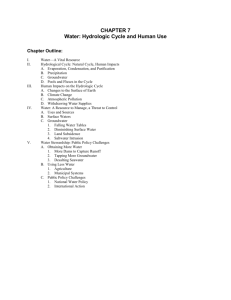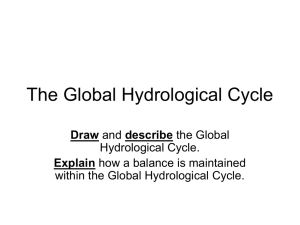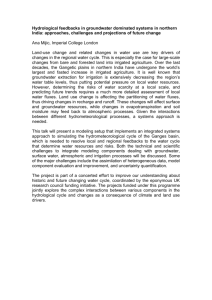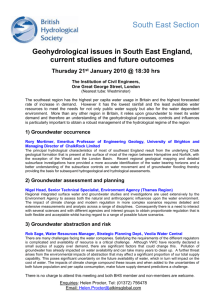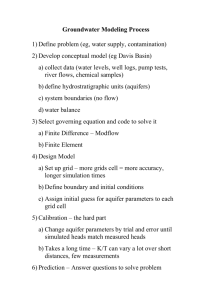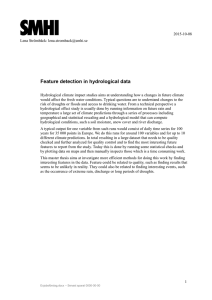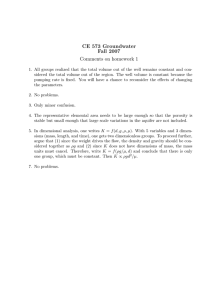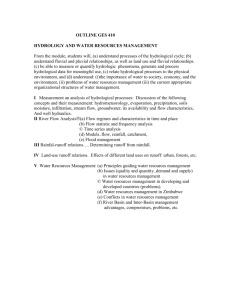Application for Employment (* delete as applicable)
advertisement
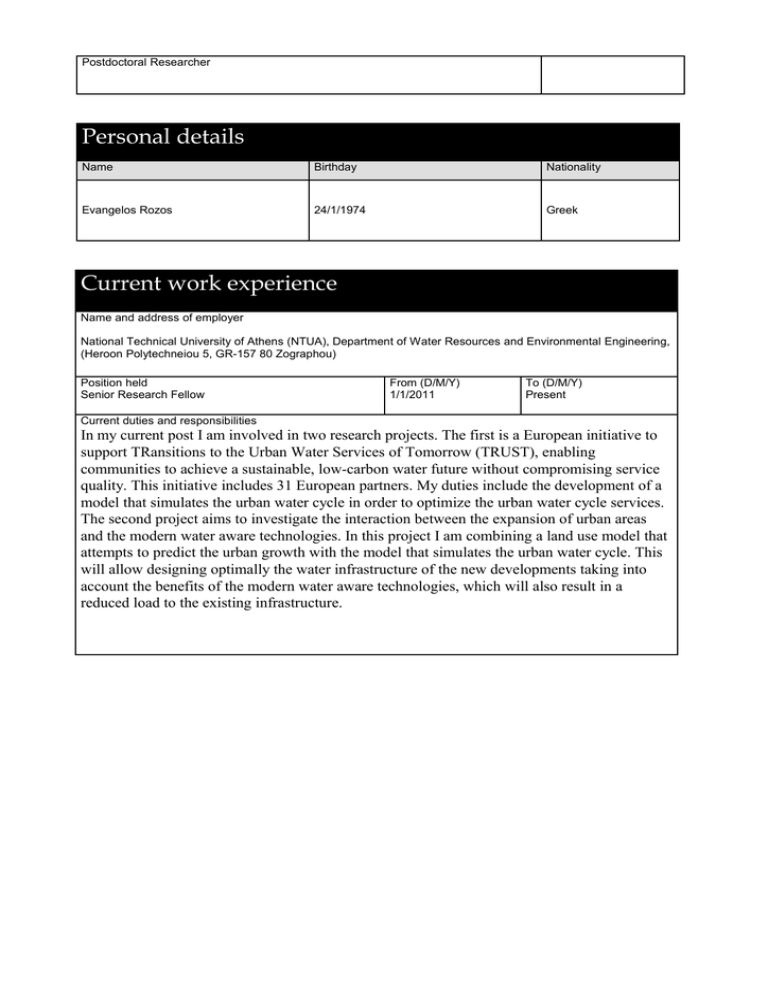
Postdoctoral Researcher Personal details Name Birthday Nationality Evangelos Rozos 24/1/1974 Greek Current work experience Name and address of employer National Technical University of Athens (NTUA), Department of Water Resources and Environmental Engineering, (Heroon Polytechneiou 5, GR-157 80 Zographou) Position held Senior Research Fellow From (D/M/Y) 1/1/2011 To (D/M/Y) Present Current duties and responsibilities In my current post I am involved in two research projects. The first is a European initiative to support TRansitions to the Urban Water Services of Tomorrow (TRUST), enabling communities to achieve a sustainable, low-carbon water future without compromising service quality. This initiative includes 31 European partners. My duties include the development of a model that simulates the urban water cycle in order to optimize the urban water cycle services. The second project aims to investigate the interaction between the expansion of urban areas and the modern water aware technologies. In this project I am combining a land use model that attempts to predict the urban growth with the model that simulates the urban water cycle. This will allow designing optimally the water infrastructure of the new developments taking into account the benefits of the modern water aware technologies, which will also result in a reduced load to the existing infrastructure. Previous work experience Dates of employment Organization Job title and main role(s) Consultant of the Deputy Secretary on IT affairs. My basic duty in this post was to support the Agency on GIS, database, and in general on IT related issues. The GIS issues included the preparation of GIS data for the obligations of Greece for the Water Framework Directive. Furthermore, I was responsible for the quality assessment of maps prepared by private consultants for the Agency. I also built shapefiles and Google Earth maps from the raw geographical data provided by other agencies. The database issues included the design, implementation and maintenance of a medium size database to store data acquired from the quality observation network of the Greek water bodies. My duties also included the preparation of specification documents and I was responsible to ensure the compliance of new electronic equipments. Finally, I was providing helpdesk services and I was supporting the smooth operation of the intranet and the electronic machines of the Agency (PCs, productivity machines, etc.). From (D/M/Y) To (D/M/Y) 1/1/2010 31/12/2010 Ministry of Environment, Energy & Climate Change, Special Secretariat for Water 1/3/2009 31/12/2009 NTUA, Department of Water Resources and Environmental Engineering, (DWREE) 1/2/2007 28/2/2009 Centre for Water Systems, University of Exeter (CWS) 1/7/1997 31/1/2007 NTUA, Department of Water Resources and Environmental Engineering (DWREE) Research Assistant. During this period I participated in the project Hydroscope. My duties included the development of the groundwater module of the hydrological application HYDROGEIOS and the development of a GUI for this application based on the open-source GIS MapWindow. I also participated in the dissemination of the knowledge obtained by this project by presenting my team's work in workshops and by preparing educational material and training others on the use of HYDROGEIOS. Research Assistant. During this period I participated in research activities related with the WaND project objectives. More specifically, I developed a decision support tool for integrated urban water management based on soft engineering. This tool, called Urban Water Optioneering Tool (UWOT), coupled with a multi-objective optimization algorithm (NSGA-II) was used to investigate existing and hypothetical developments to identify optimum configurations. I also prepared educational material and delivered lectures for the CAD lessons taught to 3rd year mechanical engineers. Research Assistant. This ten years period includes my involvement in three research projects with a total budget of 1.5 M€. My main role was to develop and apply hydrological models for the identification of the optimum management of available groundwater resources. More analytically: From June 2004 to January 2007, ODYSSEUS project. This project was conducted by a consortium comprising three consultancy companies and the research team of DWREE. The end-product included a central system for the simulation and optimization of the operation of hydrosystems and a series of separate software applications for solving specific problems. During this project I developed a parsimonious hydrogeological model based on the finite volumes method and a model that estimates the water needs for agriculture, industry, farming and potable water demand. From March 1999 to December 2003, Modernization of the supervision and management of the water resource system of Athens. During this project I applied MODFLOW along with a stochastic model to investigate the potential impacts of the climate change to the discharge of some vital springs for the water supply system of Athens. From June 1997 to January 1999, Systemization of the Thessaly raw data archive of the Ministry of Agriculture. In this project I designed a database for the irrigated land in Greece and I developed a user interface to facilitate the build of queries. Education and qualifications Period of study From To D/M/Y D/M/Y Academic qualification(s) Subject(s) Level/Grade 14/7/1998 27/4/2010 Ph.D. Hydrological simulation of flow in aquifers of high incertitude N/A 1/10/1991 1/7/1997 B.S. Civil Engineering 7/10 From D/M/Y To D/M/Y Professional qualification(s) Subject(s) Level/Grade 1/1/2007 Present Consultant Certificate Hydraulic and geological studies B Membership of professional bodies Professional body Period of membership Grade obtained Technical Chamber of Greece Since 1997 N/A Further information Statistical experience During ODYSSEUS project I studied the effects of climate change on the recharge of an aquifer that discharges to an important spring for the Athens water supply system. Monte Carlo analysis was performed to provide the 95% confidence intervals of the future variation of the spring discharge. In a recent publication (Rozos and Koutsoyiannis, 2010) I used both dynamical and statistical downscaling techniques to derive physically consistent information (take into account the influence of boundary conditions and stresses) at a finer scale about the hydraulic conditions in an aquifer. The dynamical downscaling was accomplished using MODFLOW whereas the statistical downscaling was accomplished using the universal Kriging method. The results of this study favoured the statistical method, which is simpler and provided more reliable results. I have used Matlab to develop a stochastic model (a novel 2D stochastic model that produces conductivities field with statistical structure resembling that of a real aquifer) and an a priori error estimation algorithm for the model I developed during my Ph.D. thesis. Arid and semi-arid environments In one of my recent publications (Rozos et al., 2010) I used annual precipitation trends estimated from IPCC along with a population model to develop a set of scenarios that I assessed using UWOT. I repeated this assessment for three different climatic conditions (humid, semi-arid and arid represented by Heathrow London, Paphos Cyprus and Doha Dubai) to derive more general conclusions about the impacts of climate change combined with population growth on the efficiency of the in-house water recycling schemes Groundwater modelling The main objective of my Ph.D. was the development of a ground water model adequate for waterbasin scale applications (http://www.itia.ntua.gr/en/docinfo/949/). This model is based on the finite volumes method and is very modest computationally. This allows using global optimization algorithms for parameter estimation. A carefully selected objective function can be used to extract from available data as much information as possible. For example an empirical penalty term can be used for the failure of reproducing properly the intermittency of a spring. Furthermore, with appropriate formulation of the objective function, localized conductivity/porosity measurements can be used indirectly as prior information. I have applied this model in porous and double medium (karstic) aquifers and I have tested this model in a synthetic aquifer. Integrated hydrological modelling I would like to mention my participation in the development of HYDROGEIOS, which is a semidistributed GIS-based hydrological model for modified river basins. HYDROGEIOS couples surface with groundwater modelling along with hydrosystem modelling (both natural and artificial). HYDROGEIOS characterizes the regions of a waterbasin and defines the Hydrological Response Units (HRUs) by using GIS operations on layers of land cover, slope, drainage density, infiltration capacity etc. An HRU is a set of non-contiguous areas that exhibit similar hydrological responses. Each HRU is simulated using a soil moisture module, which provides the groundwater recharge and the generated runoff. The model parameters and the optimum water basin management strategy are estimated using multi-objective optimization algorithms. HYDROGEIOS has been applied successfully by the National Observatory of Athens for the project FLASH, Observations, Analysis and Modeling of Lightning Activity in Thunderstorms, for use in Short Term Forecasting of Flash Floods. Multiple runs of HYDROGEIOS were employed to propagate the uncertainty of the forecasted precipitation. I contributed to this model by developing the groundwater module, which is based on my Ph.D., by developing the GIS interface (based on the open source GIS MapWindow) and the database that stores the geographical and hydrological data that constitute a HYDROGEIOS project. I am very proud of HYDROGEIOS, which has functionality and appearance equivalent to commercial products but is freely available to the hydrological community (down-loadable from http://itia.ntua.gr/en/softinfo/25/). Modelling natural processes During ODYSSEUS project I developed a model that estimates the water needs for agriculture, industry, farming and potable water demand. The agriculture needs are estimated using the crop coefficients from FAO multiplied with the potential evapotranspiration, which can be estimated using either Penman Montieth or Blaney Criddle. Also during this project I developed the user interface of an application that estimates the saline water intrusion using the Ghyben-Herzberg assumption and MODFLOW. The model I developed during WaND project (UWOT) is able of estimating the generated runoff of new developments. I have used UWOT to study the effects of urbanization of a natural landscape and the possible measures that can be taken to abate the runoff increase (natural response can be restored with the implementation of the proper water technologies) and to minimize the water abstractions (Rozos and Makropoulos, 2010). IT experience My early exposure on computers (age of 10) has rendered me familiar with a wide range of computer applications and development tools. I have used spreadsheet programs (MS Excel and Open Office Calc) to analyze output of models and derive charts, to prepare raw data in appropriate format for database entry and to develop simple hydrological models (e.g. reservoir input-output model, recession flow analysis for aquifer parameter estimation etc.). Experience of building standalone applications using Matlab's Simulink package was acquired while I was developing the engine of UWOT model. The increased number of requests for UWOT on the web site of the Exeter University has rendered me the most popular link in the CWS web site (see category “POPULAR” at the bottom of the CWS web page http://centres.exeter.ac.uk/cws/). My long experience with Linux has taught me the use of basic Unix text tools (awk, grep, sort, regular expressions, bash scripts) for collecting and handling effectively large amounts of data. I am also very familiar with medium size databases (MS Access, DBFManager) and with SQL queries, which I have frequently used during my research activities to organize bulk data and extract information from them. I have developed applications and tools in the following programming languages: Object Pascal/Delphi (a program that estimates the water needs developed during ODYSSEUS project and the groundwater model developed during my Ph.D.), Visual Basic (the HYDROGEIOS plug-in for MapWindow), VBA (the interface of UWOT), C (a wrapper for the binary produced by the Simulink compiler, the initial version of the model of my Ph.D.) and Fortran (minor modifications to MODFLOW source for simulating non laminar flows). Optimization experience During my Ph.D. I used the Shuffled Complex Evolution (SCE) algorithm to calibrate the parameters of my model. I have also used PEST to calibrate the parameters of MODFLOW, whose solutions were used as reference to check the accuracy of the model I have developed. I have also used NSGA-II to derive Pareto-Fronts between economic (operational, capital cost, consumed energy) and operational indexes (potable water demand, generated runoff, and waste water discharge) for the optimum design of new developments. Consultancy experience During my career I have had the opportunity to be involved in two major consultancy projects. The first consultancy project (1999-2003) was for the Water Supply and Sewerage Company of Athens. The success of this project was very important since it contributed to the smooth running of the Athens Olympic Games. The second consultancy project was for a private company the Tourist Enterprises of Messinia (TEMES). During this study I estimated the available groundwater resources of the Xerias and Yannouzagas basins and contributed to a technically-sound report that TEMES used to persuade the local authorities to grant the request for reasonable use of local water resources for the needs of a new tourist facility. Laboratory/field experience I have obtained experience of laboratory research from the periodic water quality measurements I conducted from March 2004 until December 2006. I voluntarily performed these measurements because there were concerns about the quality of the DWREE building water, which is supplied from a borehole inside the university campus. I was also maintaining a web page (http://www.itia.ntua.gr/~rozos/wquality/) to display the results of the measurements. I have obtained experience of field research from the river flow measurements (Xerias and Yannouzagas rivers) that I conducted during the project for TEMES. Publications The total number of my scientific publications is 27 (visit http://itia.ntua.gr/rozos/ for a complete list of publications). This number includes: 6 publications in scientific journals (see list below), 15 conference publications with evaluation of abstract, 2 fully evaluated conference publications and 4 presentations in workshops. I have been reviewer for Journal of Hydrology (2 reviews), Hydrological Sciences Journal (6 reviews), Urban Water Journal (6 reviews) and Water Resources Management (1 review). I was one of the reviewers (my name is mentioned in the Acknowledgements) that helped the editing of the book Climate Change and Groundwater by W. Dragoni and B. S. Sukhija published by Geological Society of London. Working within a team During the twelve years (ten years in Greece, two years in UK) of my professional career I have been successfully working within a team. During the working hours I have enjoyed learning from the rest members of the team, passing my knowledge to them and achieving difficult targets. During the leisure times I have enjoyed the friendship of the rest members of the team and quite often we have participated together in athletic activities (squash, badminton) or social activities (choir, salsa parties, dinners).
